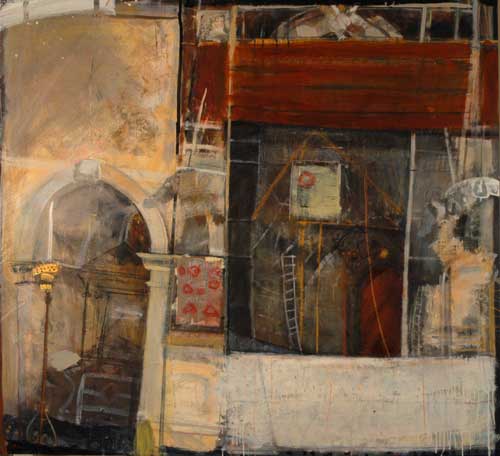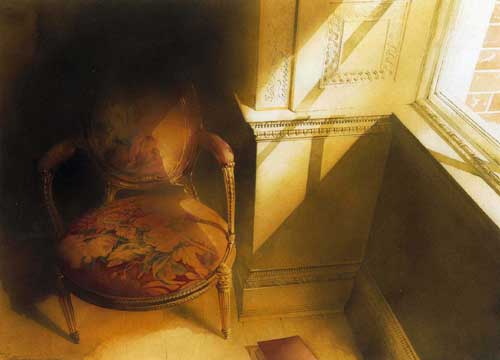Hector McDonnell: New York
Solomon Gallery, Dublin
27 August-15 September 2004
John Brown: Missing Venice
The Scottish Gallery, Edinburgh
11 October-3 November 2004
Paintings of Hugh Buchanan
Francis Kyle Gallery, London
10 November-9 December 2004

John Brown. Seeking Miss Garnet's Angel. Mixed media, 25.5 x 25.5 cms
Hector McDonnell first visited New York from Ireland in 1985. The recent exhibition of his work in Dublin is the latest in a number of exhibitions to use the city as inspiration. According to McDonnell, this inspiration comes from 'the sheer intensity of life there, in part its endless contradictions, in part its vital force'. The artist now lives in New York and his new work combines the everyday aspects of life with a young family with the terrible consequences of 11 September 2001. The Ground Zero paintings were created after the pilgrimage that McDonnell and his family - along with many others - made there, shortly after his return to the States, having been in London on 11 September itself. He has said, 'It would take a great deal to express my feelings in words about that time and the several return visits I made over the subsequent weeks. It aroused a sense of deep horror and a feeling that we were witnesses to something that, in some way we could not define and that was of enormous significance to our world's future.' McDonnell's paintings celebrate the minutiae of life, family and everyday existence and in doing so create a quiet sense of hope.
John Brown's 'Missing Venice' at the Scottish Gallery in Edinburgh has the nostalgic air of the visitor having returned to the reality of home, while also conjuring memories of a more exotic place. Venice has always held a strong attraction for Scottish artists, as the scholarship accompanying 'The Age of Titian', at the National Galleries of Scotland, testifies.
For Brown, this exhibition comes a year after his successful 'Zanzibar' exhibition at the Richmond Hill Galleries, London. The paintings reveal a working method and personal response beyond the ready market for tourist-oriented mementos. Brown's work, in fact, reveals both his love of the craft of painting and a methodological approach informed by his years as a dedicated teacher of art. He only came to painting full-time in his late 40s, having taught for almost 30 years, latterly at the Edinburgh College of Art and Leith College. The Venice works were begun on a short trip to the city, where Brown mostly observed and photographed. A short time later, on a longer visit, he made small, atmospheric drawings in sketchbooks using a personal shorthand, so that on his return to the studio he could evoke the 'sense of being there' and the essence of place.

Hugh Buchanan, Osterley I. 29.25 x 41.5in 74 x 105cm
'Missing Venice' contains over 60 paintings, large and small, which seek to present what Brown perceives to be the two extremes of the city - the hidden and the revealed. Mysterious, misty images of canals and lagoons hang alongside larger canvases depicting the more bawdy and theatrical side of Venetian life, with the bright colours of masks and costumes and the gold of the gondolas. The contemporary light and colour, as well as the sense of history and architectural majesty are used to create a sense of excitement and personal pleasure. Brown's works are underpinned by his fine draughtsmanship, his attention to detail and the symphony of colour he creates, not only in his painterly works but also those using mixed media, which verge on abstraction.
Scottish artist Hugh Buchanan's exhibition of recent paintings at the Francis Kyle Gallery in London is his tenth exhibition there. His distinctive watercolours on this occasion are dedicated to the interiors of five great houses: Syon House and Osterley House outside London, Harewood House in Yorkshire, Broughton House in Northamptonshire and Blairquhan in Ayreshire. Buchanan has always gravitated to fabulous and beautiful places for his subjects and has tended to focus on light rather than the architecture itself; his work is characterised by falling light and elegant shadows. The present exhibition, however, focuses on texture and pattern, through close-up studies of fabrics and furniture.
Buchanan was born in Edinburgh in 1958 and educated at the Edinburgh College of Art. After his studies, he received travelling scholarships to the Middle East, North Italy and the Balkans. Today, he travels regularly throughout Europe to paint buildings and interiors, from the Renaissance to the Baroque. He works almost exclusively in watercolour, and like David Hockney, has recently worked on a scale unprecedented in traditional watercolour painting. Buchanan has worked on commissions for the National Trust and also for the Prince of Wales, on a series of interiors of Balmoral and Highgrove.
In watercolour, Hugh Buchanan renders the surfaces of gilt, wood veneer, tapestry and brocade with an extraordinary perfection and drama. The subjects in this exhibition put his skills to the test: ivory inlay on doors, light on tapestry chairs, tattered stretches of brocade damask wallpaper and flaking gold leaf. Huon Mallalieu observes, 'There is in these furnishings a seductive, narrative element which finds expression, for instance, in the vignettes of rustic children on the chair backs drawn from Boucher’s 'Jeux des enfants', a sequence of embroidered works and tapestries produced at the Gobelins workshops and destined originally for Madame de Pompadour'.
A human presence is mysteriously evoked in Hugh Buchanan's unpeopled interiors, as if the inhabitants have been granted their privacy. While remaining true to the craft and tradition of watercolour painting, in his recent work, Buchanan has also extended its suitability with great proficiency.